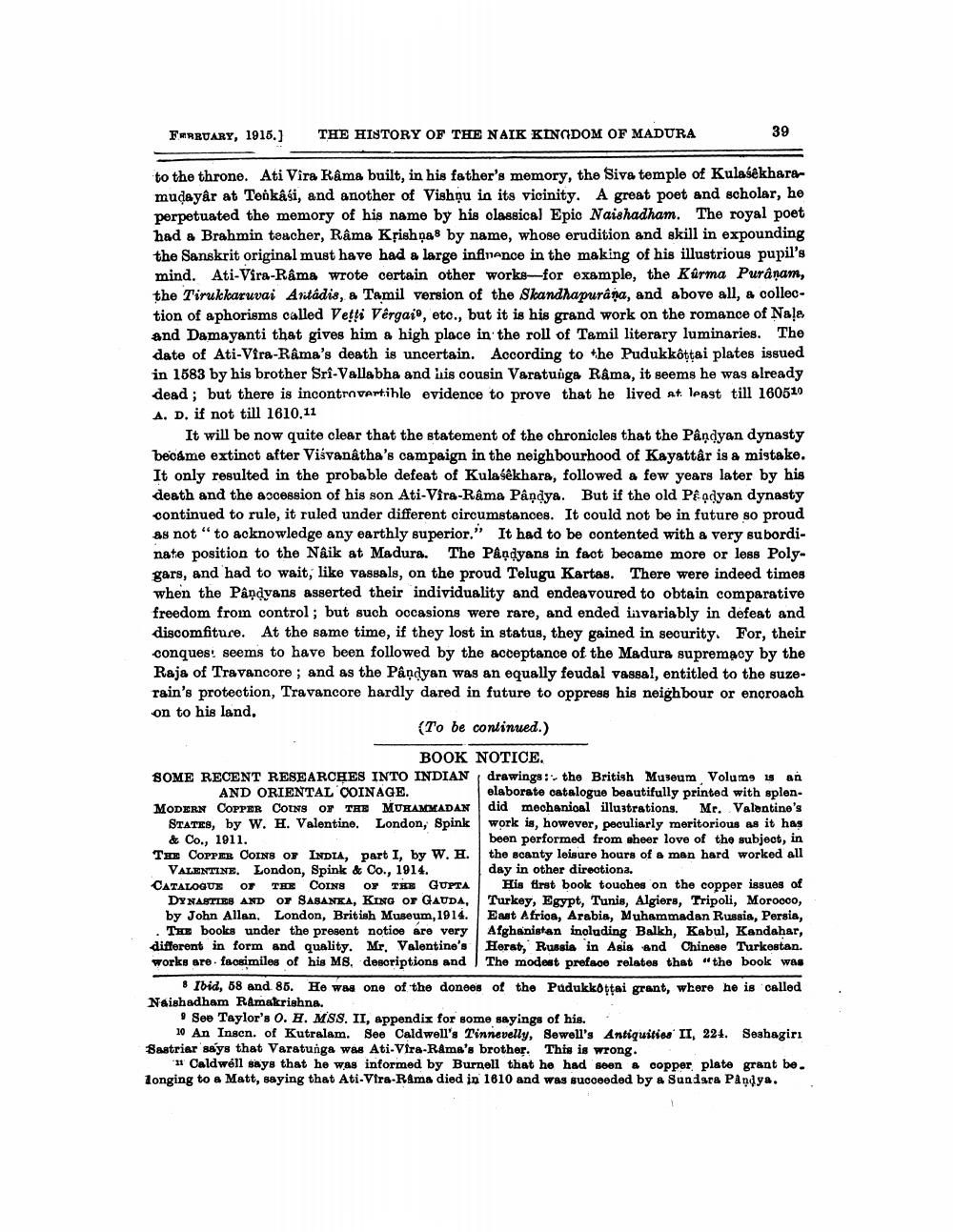________________
THE HISTORY OF THE NAIK KINGDOM OF MADURA
FARRUARY, 1916.)
RA
39
to the throne. Ati Vira Kama built, in his father's memory, the Sive temple of Kulasekharamudayâr at Tenkasi, and another of Vishnu in its vicinity. A great poet and scholar, he perpetuated the memory of his name by his classical Epio Naishadham. The royal poet had a Brahmin teacher, Râma Krishņa8 by name, whose erudition and skill in expounding the Sanskrit original must have had a large infinance in the making of his illustrious pupil's mind. Ati-Vira-Rama wrote certain other works-for example, the Kurma Puranam, the Tirukkaruvai Artadis, a Tamil version of the Skandhapurana, and above all, & collection of aphorisms called Vetri Vergaio, etc., but it is his grand work on the romance of Nale, and Damayanti that gives him a high place in the roll of Tamil literary luminaries. The date of Ati-Vira-Rama's death is uncertain. According to the Pudukkottai plates issued in 1583 by his brother Sri-Vallabha and his cousin Varatuiga Rama, it seems he was already dead; but there is incontrovertible evidence to prove that he lived at least till 160510 A. D. if not till 1610.11
It will be now quite clear that the statement of the chronicles that the Pandyan dynasty became extinct after Visvanatha's campaign in the neighbourhood of Kayattâr is a mistake. It only resulted in the probable defeat of Kulasekhara, followed a few years later by his death and the accession of his son Ati-Vira-Rama Pandya. But if the old Peadyan dynasty continued to rule, it ruled under different circumstances. It could not be in future so proud as not "to acknowledge any earthly superior.” It had to be contented with a very subordinate position to the Nâik at Madura. The Pandyans in fact became more or less Polygars, and had to wait, like vassals, on the proud Telugu Kartas. There were indeed times when the Pandyans asserted their individuality and endeavoured to obtain comparative freedom from control; but such occasions were rare, and ended invariably in defeat and discomfiture. At the same time, if they lost in status, they gained in security. For, their conques: seems to have been followed by the acceptance of the Madura supremacy by the Raja of Travancore ; and as the Pandyan was an equally feudal vassal, entitled to the suzerain's protection, Travancore hardly dared in future to oppress his neighbour or encroach on to his land,
(To be continued.)
BOOK NOTICE. SOME RECENT RESEARCHES INTO INDIAN drawings, the British Museum Volume 1 an AND ORIENTAL COINAGE.
elaborate catalogue beautifully printed with splenMODERN COPPER COINS OF THE MUHAMMADAN did mechanical illustrations. Mr. Valentine's
STATES, by W. H. Valentine. London, Spink work is, however, peculiarly meritorious as it has & Co., 1911.
been performed from sheer love of the subject, in THE COPPER COINS OF INDIA, part I, by W. H. the scanty leisure hours of a man hard worked all VALENTINE. London, Spink & Co., 1914.
day in other directions. CATALOGUE OF THE COINS OF THE GUPTA His first book touches on the copper issues of
DYNASTIES AND OF SASANKA, KING OF GAUDA, Turkey, Egypt, Tunis, Algiers, Tripoli, Morocco, by John Allan, London, British Museum, 1914. East Afrioa, Arabia, Muhammadan Russia, Persia,
The books under the present notice are very Afghanistan inoluding Balkh, Kabul, Kandahar, different in form and quality. Mr. Valentine's Herst, Russia in Asia and Chinese Turkestan. works are facsimiles of his MB, descriptions and The modest preface relates that "the book was
# Ibid, 58 and 85. He was one of the donees of the Pudukkottai grant, where he is called Naishadham Ramakrishna.
See Taylor's 0. H. MSS. II, appendix for some sayings of his.
10 An Inscn. of Kutralam. See Caldwell's Tinnevelly, Sewell's Antiquities II, 224. Seshagiri Sastriar says that Varatunga was Ati-Vira-Rama's brother. This is wrong.
11 Caldwell says that he was informed by Burnell that he had seen # copper plate grant be. longing to a Matt, saying that Ati-Vira-Rama died in 1610 and was suooooded by a Sundara Pandya. ,




